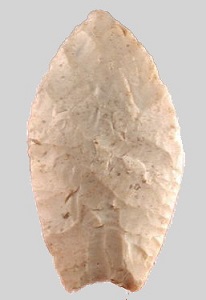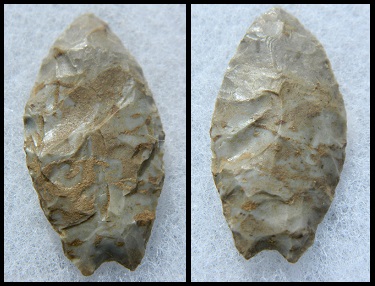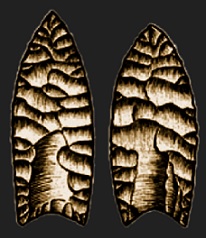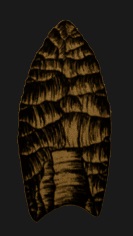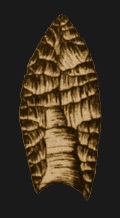Outline is Representative of Size and Shape:
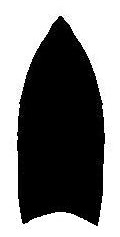
Name Details:
Identified By: James E Fitting, Jerry DeVisscher, Edward J. Wahla
Named For: Type Site
Date Identified: 1966
Type Site: Holcombe Site (Holcombe Beach), Macomb County, Michigan
Identified By: James E Fitting, Jerry DeVisscher, Edward J. Wahla
Named For: Type Site
Date Identified: 1966
Type Site: Holcombe Site (Holcombe Beach), Macomb County, Michigan
Point Validity:
Valid type
Fitting was an anthropologist who serves as the first state archaeologist for the State of Michigan. He was a professor of Anthropology at the Case Western Reserve University and went on to earn a law degree and became a lawyer for the Navajo Nation. DeVisscher and Wahla are amateur archaeologists who discovered the Holcombe site. This point was named in a professional publication and has many professional references. This is considered a valid type.
Fitting was an anthropologist who serves as the first state archaeologist for the State of Michigan. He was a professor of Anthropology at the Case Western Reserve University and went on to earn a law degree and became a lawyer for the Navajo Nation. DeVisscher and Wahla are amateur archaeologists who discovered the Holcombe site. This point was named in a professional publication and has many professional references. This is considered a valid type.
Holcombe Fluted
AKA: Pumpkin Seed Fluted (DeRegnaucourt 1991)Cluster: Clovis Cluster
Description of Physical Characteristics and Flaking Pattern:
This is a thin small to medium lanceolate point with a flattened cross section. The blade is broad and excurvate and constrict in towards the base. This point has the narrowest base of all the Clovis variants. The widest part of the blade is at or above the midway point. The base is concaved and generally has sharp thin basal ears and lacks a "fishtail" appearance. Light to heavy basal and lateral edge grinding is commonly seen on these points. This point is commonly fluted on one face with the flute length roughly matching the basal width. However, on very thin examples where the base was already thin enough for hafting, fluting is commonly absent (Morrow, 2016). The flaking pattern may vary from random to collateral or parallel transverse patterns.
Size Measurements:
Length - 34 to 70 mm (mean 51.6 mm), Max Blade Width - 16 to 28 mm (mean 21.6 mm), Basal Width - 13 to 27 mm (mean 18.8 mm), Basal Concavity - 5 mm or less, Basal Thinning flake length - 4 to 29 mm (mean 14.9 mm), Thickness - 3 to 7 mm (mean 4.9 mm).
Length - 34 to 70 mm (mean 51.6 mm), Max Blade Width - 16 to 28 mm (mean 21.6 mm), Basal Width - 13 to 27 mm (mean 18.8 mm), Basal Concavity - 5 mm or less, Basal Thinning flake length - 4 to 29 mm (mean 14.9 mm), Thickness - 3 to 7 mm (mean 4.9 mm).
Commonly Utilized Material:
Locally available white and gray Bayport chert, black and gray Upper Mercer chert in Ohio, and tan Onondaga chert in Ontario. Jaspers are used when present. When present other cherts include Kettle point chert and Tenmile chert.
Locally available white and gray Bayport chert, black and gray Upper Mercer chert in Ohio, and tan Onondaga chert in Ontario. Jaspers are used when present. When present other cherts include Kettle point chert and Tenmile chert.
Additional Comments:
These points never have the appearance of a shoulder or have a pentagonal appearance like seen on Crowfield points. They are generally thinner than Crowfield points with more extensive fluting(W14).
This point is thought to have evolved from the earlier Crowfield point (W2).
These points never have the appearance of a shoulder or have a pentagonal appearance like seen on Crowfield points. They are generally thinner than Crowfield points with more extensive fluting(W14).
This point is thought to have evolved from the earlier Crowfield point (W2).
Distribution: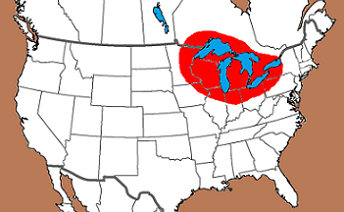
Distribution Comments:
This point is primarily found in Michigan and the Great Lakes region.
This point is primarily found in Michigan and the Great Lakes region.
Age / Periods:
Date: 10,500 - 10,000 B.P.
Cultural Period: Late Paleo
Glacial Period: Late Pleistocene
Culture:
Date: 10,500 - 10,000 B.P.
Cultural Period: Late Paleo
Glacial Period: Late Pleistocene
Culture:
Age Details:
Other points in this cluster / Related / Associated Points:
Clovis, Clovis Hazel, Clovis St. Louis, Clovis St. Louis, Clovis Tulare Lake, Clovis Un-fluted, Debert, Redstone
Clovis, Clovis Hazel, Clovis St. Louis, Clovis St. Louis, Clovis Tulare Lake, Clovis Un-fluted, Debert, Redstone

